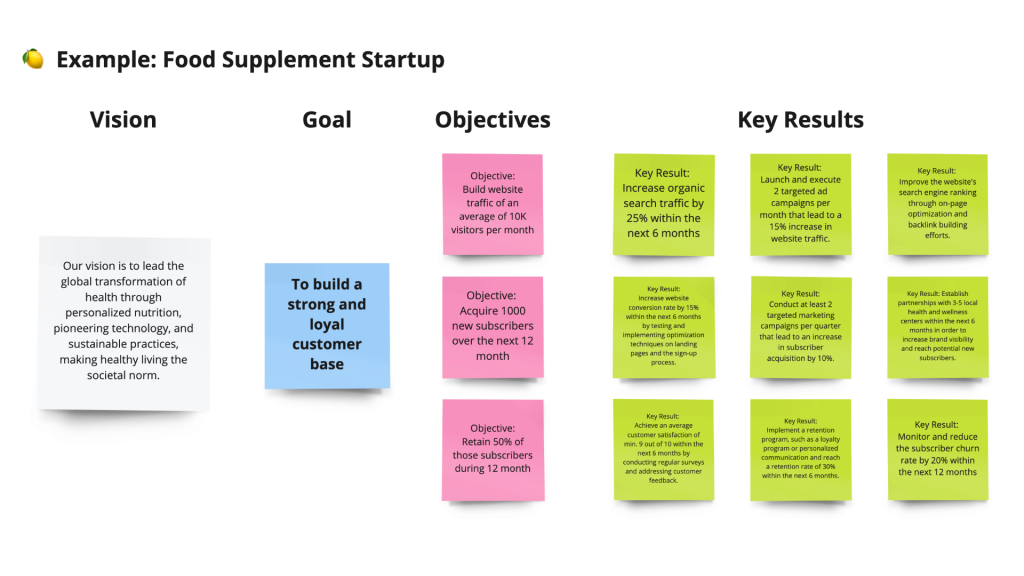💡 What is Vision & OKR Alignment?
Vision alignment is crucial for the success of any venture, ensuring that your team, whether small or large, moves in the same direction. It involves establishing a common vision, mission, and values, and defining clear objectives. Objectives and Key Results (OKRs) play a vital role in this process, providing a goal-setting framework for specific, measurable objectives aligned with the company’s strategy. OKRs are complemented by key results that track progress toward these objectives. In essence, vision alignment, coupled with the use of OKRs, creates a powerful framework guiding teams toward sustainable success.
🚀 Why is Vision & OKR Alignment Important for Startup Founders?
As a founder you need an aligned vision and OKRs to provide a clear identity and purpose for your venture. It sets the direction and purpose for your team and stakeholders. Going through the short process of aligning your vision and OKRs will help you to gain:
- Enhanced Team Collaboration: Aligning on a common vision fosters teamwork and collaboration among team members.
- Improved Decision-Making: A shared vision and clear objectives help in making decisions that are in line with the long-term goals of the business.
- Clear Direction: Vision alignment provides a clear direction for the team, reducing confusion and ensuring everyone is on the same page.
- Increased Motivation: Knowing the purpose and goals of the venture motivates team members to work towards a common objective.
- Efficient Resource Utilization: Clarity about the desired key results ensure that resources are directed towards achieving common goals, avoiding wastage.
🗒️ Vision & OKR Alignment Step-by-Step
Embarking on a journey to align your organization’s vision with concrete objectives can be a transformative process, fostering clarity and direction. This step-by-step guide navigates you through the intricacies of this alignment, emphasizing the significance of values, mission, and vision statements. Let’s dive into each step for a structured and strategic pathway toward an aligned business vision and objectives.
✅ Step A: Value Identification
- Generate a List of Values: First of all, get your team together in a collaborative brainstorming session to generate a comprehensive list of values that align with the business ethos.
- Categorize your Values: Now try to group these values into categories such as professional, personal, ethical, innovation, collaboration, and sustainability to provide a structured understanding. And finally vote in the team to select your final value considering their importance and emphasizing the significance of each value in shaping the company’s culture and operations.
✅ Step B: Mission Statement
- Formulate your Mission: Utilize the Golden Circle framework by Simon Sinek to formulate your mission. Start with the ‘why’ articulating the fundamental purpose and beliefs driving your business, in other words your mission. Then describe ‘how you are doing things differently’ outlining the unique experience you are providing. And finally describe ‘what you are actually offering’ namely your specific products or services. You can draft various ideas for your mission statement with the whole team and finally vote to select the most adequate version.
- Review your Mission: Ensure that the mission statement aligns seamlessly with the values identified in Step A, fostering a coherent and integrated company identity. Ensure the mission statement is clear, specific, relevant, aspirational, and authentic, promoting a compelling and genuine narrative.

✅ Step C: Vision Statement
- Craft an Inspiring Vision Statement: Now you can craft a vision statement that is both inspiring and achievable, providing a clear picture of the company’s aspirations and future direction. You can again brainstorm various ideas for your vision statement with the whole team and finally select the one that best encapsulates the shared aspirations and long-term goals of the company.
- Consideration of Factors: Deliberate on long-term goals, values, principles, and the intended impact on stakeholders to inform the creation of a forward-thinking vision statement.
✅ Step D: Setting Objectives
- Define your strategic goals: Establish your strategic (high-level) goals by recognizing your company’s long-term aspirations, envisioning the future you aim to shape for your business, and outlining the desired outcomes you intend to achieve in a given time frame (e.g. 3 years). Brainstorm again (with the team) and list all the long-term goals that come to your mind. Then vote and select the most crucial long-term goals (up to 5).
- Define SMART Objectives: Now for each chosen long-term goal you want to define a series of middle- to short-term objectives on a more detailed level. The fulfillment of which will lead you to achieving your goals. Ensure that these objectives are Specific, Measurable, Achievable, Relevant, and Time-bound.
✅ Step E: Key Result Definition
- Define the Key Results for Each Objective: Last but not least you want to to define the key results for each objective. These are specific metrics to track progress for each objective, providing quantifiable indicators of success. By setting clear key results, you empower yourself to measure achievements, guide strategic decisions, and ensure the tangible realization of your company’s objectives.
In conclusion, aligning your business vision and objectives is a fundamental step towards building a successful venture. It provides a clear roadmap, enhances collaboration, and ensures everyone is working towards common goals. Regularly review and revise your vision and objectives to stay relevant and focused on the path to success.

Get Ready-to-Use Templates and Practical Guidances . 🚀
Check out our basecamp for founders for practical guidance and templates on Market Environment Analysis and many more business building methodologies.

